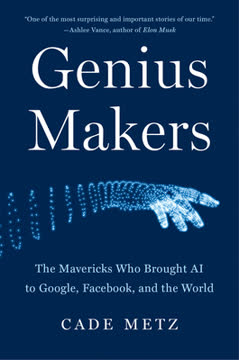Key Takeaways
1. Automation is rapidly transforming the job market across all sectors
Robots and self-service technology in the service sector will continue to make inroads, holding down wages and leaving relatively unskilled workers with fewer options.
Widespread disruption. Automation is no longer confined to manufacturing, but is rapidly spreading to services, retail, agriculture, and knowledge work. Technologies like industrial robots, self-service kiosks, and AI systems are eliminating jobs or reducing wages across industries. This trend is accelerating as capabilities improve and costs decrease.
Few jobs are safe. Even skilled professions once thought immune to automation are now at risk. Legal research, financial analysis, medical diagnosis, and other knowledge-intensive fields are being disrupted by artificial intelligence and big data systems. As machine learning and robotics advance, an ever-growing share of human labor is at risk of being automated away.
2. White-collar jobs are increasingly vulnerable to technological disruption
Watson is currently the most ambitious and prominent application of artificial intelligence to medicine, but there are other important success stories as well.
AI in knowledge work. Artificial intelligence systems like IBM's Watson are increasingly capable of performing knowledge-intensive tasks once thought to require human-level intelligence. These include medical diagnosis, legal research, financial analysis, and even creative work like writing news articles.
Automation of analysis. Big data and machine learning allow computers to analyze vast amounts of information and identify patterns that humans may miss. This enables automation of many analytical and decision-making tasks in fields like finance, marketing, and management. Even high-level strategic planning may eventually be performed by AI systems.
Key white-collar fields at risk:
- Law (e.g. legal research, document review)
- Medicine (e.g. diagnosis, treatment planning)
- Finance (e.g. investment analysis, algorithmic trading)
- Journalism (e.g. automated article writing)
- Management (e.g. data-driven decision making)
3. The relationship between productivity and wages has broken down
Measured in 2013 dollars, a typical worker—that is, production and nonsupervisory workers in the private sector, representing well over half the American workforce—earned about $767 per week in 1973. The following year, real average wages began a precipitous decline from which they would never fully recover.
Wage stagnation. Despite dramatic increases in productivity and economic growth over the past few decades, wages for most workers have stagnated or even declined in real terms. This represents a fundamental break from the historic relationship between rising productivity and rising wages.
Gains go to capital. The benefits of increased productivity are now accruing primarily to business owners and investors rather than workers. Labor's share of national income has fallen dramatically, while corporate profits have soared to record levels. This shift reflects the growing power of capital relative to labor in an increasingly automated economy.
4. Income inequality is soaring as capital captures more economic gains
Between 1993 and 2010 over half of the increase in US national income went to households in the top 1 percent of the income distribution.
Extreme concentration of wealth. As automation allows businesses to produce more with fewer workers, an increasing share of economic gains is flowing to a small elite of business owners and investors. This is driving income inequality to extreme levels not seen since before the Great Depression.
Shrinking middle class. The middle class is being hollowed out as mid-skill jobs disappear and workers are pushed into lower-wage service jobs. This polarization of the job market is eroding the broad-based prosperity that characterized the post-war era.
Key inequality statistics:
- Top 1% captured 95% of income gains 2009-2012
- CEO-to-worker pay ratio increased from 20:1 in 1965 to 312:1 in 2017
- Wealth of 3 richest Americans equals bottom 50% combined
5. Globalization and offshoring amplify the effects of automation
As more people lose the dependable income stream that anchors them into the middle class, they are likely to increasingly turn to these long-tail opportunities in the digital economy.
Global competition for jobs. Information technology enables companies to easily move many jobs overseas to lower-wage countries. This puts additional downward pressure on wages in developed economies and further reduces job opportunities for displaced workers.
Race to the bottom. As automation progresses, even developing countries are losing manufacturing jobs. There is a global race to the bottom in terms of wages as workers everywhere compete against machines and low-cost labor in other countries. This makes it increasingly difficult for workers to earn a middle-class income.
6. Education alone is insufficient to address technological unemployment
If we were to draw a graph of the gains from ever-increasing investment in education, it seems very likely that we would end up with something that looks like the S-curves we discussed in Chapter 3. The low-hanging fruit of further education is long behind us.
Limits of education. While education and training have historically been seen as the solution to technological disruption, this approach is reaching its limits. There are not enough high-skill jobs to absorb all displaced workers, even if they could be retrained. Many college graduates are already underemployed.
Skill-biased technological change. New technologies tend to favor highly skilled workers while displacing or devaluing less skilled labor. This exacerbates inequality and makes it difficult for displaced workers to transition to new jobs, regardless of education level.
7. A basic income guarantee may be necessary to address job displacement
A guaranteed income might help increase marriage rates among lower-income groups, while helping to reverse the trend toward more children being raised in single-parent households.
Universal safety net. As automation eliminates a growing share of jobs, a guaranteed basic income may become necessary to ensure social stability and maintain consumer demand. This would provide a minimal level of economic security for all citizens.
Market-based approach. A basic income would be more efficient than traditional welfare programs and would preserve consumer choice. It could help stimulate entrepreneurship by providing a safety net for risk-taking. However, careful policy design is needed to maintain work incentives and economic dynamism.
8. Healthcare costs pose a significant challenge to automation benefits
As of 2012, health care represented less than 6 percent of the US economy. By 2013 it had nearly tripled, having grown to nearly 18 percent, and per capita health care spending in the United States had soared to a level roughly double that of most other industrialized countries.
Rising healthcare burden. Healthcare costs continue to rise much faster than overall economic growth, consuming an ever-larger share of GDP. This threatens to offset many of the potential economic gains from increased automation and productivity growth.
Resistance to automation. Unlike other sectors, healthcare has been slow to achieve productivity gains through automation. High costs and regulatory barriers have limited adoption of potentially transformative technologies. Addressing inefficiencies in healthcare delivery and payment systems is crucial to realizing the full benefits of automation.
9. New technologies like 3D printing will reshape manufacturing
Three-dimensional printing is ideal for producing highly customized "one-off" products. The technology is already being used to build dental crowns, bone implants, and even prosthetic limbs.
Distributed manufacturing. 3D printing and other advanced manufacturing technologies will enable more localized, customized production. This could reshape global supply chains and eliminate many traditional manufacturing and logistics jobs.
New possibilities. These technologies enable the creation of complex designs and materials not possible with traditional methods. This opens up new possibilities in fields like medicine, aerospace, and consumer products. However, the job creation potential may be limited as these technologies are highly automated.
10. Self-driving vehicles could eliminate millions of transportation jobs
Google's cars navigate by relying on precision location awareness via GPS together with vast amounts of extremely detailed mapping data. The cars also, of course, have radars, laser range finders, and other systems that provide a continuous stream of real-time information and allow the car to adapt to new situations.
Massive job displacement. Autonomous vehicles could eliminate millions of jobs in trucking, taxi and ride-sharing services, and other transportation-related fields. This represents one of the largest and most imminent threats of technological unemployment.
Ripple effects. The shift to self-driving vehicles will have far-reaching impacts beyond direct job losses. It could reshape urban planning, real estate, energy consumption, and many other aspects of the economy and society.
11. Artificial general intelligence poses existential risks and opportunities
If such an intelligence explosion were to occur, it would certainly have dramatic implications for humanity. Indeed, it might well spawn a wave of disruption that would scale across our entire civilization, let alone our economy.
Profound transformation. The development of artificial general intelligence (AGI) - AI systems with human-level general intelligence - could trigger an "intelligence explosion" leading to superintelligent AI. This could produce rapid technological advances far beyond human capabilities.
Existential risks. Superintelligent AI could pose existential risks to humanity if not carefully controlled and aligned with human values. However, it could also potentially solve many of humanity's greatest challenges. Careful research and governance is needed to navigate this transition safely.
12. We must rethink our economic paradigm for the age of automation
The decades-long struggle to adopt universal health coverage in the United States probably offers a pretty good preview of the staggering challenge we will face in attempting to bring about any kind of whole-scale economic reform.
Fundamental restructuring needed. Our current economic system and social institutions are not well-suited to a world of widespread automation and technological unemployment. We need to rethink core concepts like the nature of work, education, and economic distribution.
Political challenges. Making the necessary transitions will require overcoming enormous political and ideological obstacles. However, failure to adapt could lead to economic stagnation and social instability. We must begin serious discussion of these issues before the full impacts of automation arrive.
Last updated:
FAQ
What's Rise of the Robots about?
- Focus on Automation Impact: Rise of the Robots by Martin Ford examines how automation and AI are transforming the job market, threatening both blue-collar and white-collar jobs.
- Economic Consequences: The book discusses potential outcomes like massive unemployment and increased inequality, which could destabilize the consumer economy.
- Call to Action: Ford urges policymakers and society to proactively address these challenges to ensure broad-based prosperity rather than catastrophic inequality.
Why should I read Rise of the Robots?
- Understanding Future Job Markets: The book provides insights into how automation is reshaping employment opportunities, crucial for anyone concerned about their career prospects.
- Awareness of Economic Trends: It highlights economic trends like rising inequality and stagnant wages, helping readers make informed decisions about education and careers.
- Informed Policy Discussion: Ford's arguments encourage engagement in discussions about economic policy and the future of work, relevant for students, educators, and professionals.
What are the key takeaways of Rise of the Robots?
- Job Displacement Risk: Automation threatens many jobs, including those requiring advanced degrees, emphasizing the need for workers to adapt.
- Inequality and Economic Instability: Without intervention, automation could lead to increased inequality and economic instability, threatening consumer-driven growth.
- Need for New Economic Paradigms: Traditional economic models may not suffice in a machine-dominated world, necessitating new paradigms to address technological disruption.
What are the best quotes from Rise of the Robots and what do they mean?
- "The machines are coming for the higher-skill jobs as well.": Highlights the urgency for workers to adapt as automation affects even high-skill professions.
- "Our Goldilocks period has reached its end.": Signals a shift from a time of linked economic growth and job creation to a future where technology may not lead to job growth.
- "We must decide, now, whether the future will see broad-based prosperity or catastrophic levels of inequality.": Emphasizes the critical choice society faces in addressing automation challenges.
How does Martin Ford define automation in Rise of the Robots?
- Automation as a Disruptive Force: Defined as technology performing tasks previously done by humans, with accelerating disruption across industries.
- Types of Automation: Includes robotics and AI, capable of replacing both manual and cognitive tasks, described as "a truly general-purpose technology."
- Long-Term Implications: Warns of significant job losses and economic shifts, stressing the need for proactive societal adaptation.
What role does artificial intelligence play in Rise of the Robots?
- AI's Role in Job Displacement: AI enables machines to perform cognitive tasks, blurring the line between labor and capital capabilities.
- Impact on Knowledge Workers: Knowledge-based jobs, like law and journalism, are increasingly at risk, with AI systems outperforming humans in efficiency.
- Need for New Skills: Workers must acquire new skills to remain relevant, as traditional education may not suffice for future job market demands.
How does Rise of the Robots address economic inequality?
- Inequality as a Consequence: Automation and AI likely exacerbate economic inequalities, concentrating wealth among technology owners while displacing workers.
- Consumer Demand Impact: Rising inequality threatens consumer demand, as fewer people will have purchasing power, risking economic decline.
- Policy Recommendations: Suggests policies like a basic income guarantee to support displaced workers and maintain consumer spending.
What solutions does Rise of the Robots propose for the challenges of automation?
- Basic Income Guarantee: Advocates for a basic income to provide financial security for those displaced by automation, ensuring economic stability.
- Investment in Education and Training: Stresses the importance of aligning education and training with future job market needs, despite limitations.
- Regulatory Changes: Calls for regulatory changes to address market power imbalances, ensuring fair wages and conditions in an automated workforce.
How does Rise of the Robots view the future of work?
- Transformation of Job Market: Predicts significant job market transformation, with traditional jobs disappearing and new roles requiring different skills emerging.
- Increased Job Polarization: Foresees pronounced job polarization, with high-skill, high-wage jobs and low-skill, low-wage jobs, shrinking the middle class.
- Need for Adaptation: Emphasizes societal adaptation through proactive policies and innovative solutions, rethinking work and income roles.
What are the implications of Rise of the Robots for policymakers?
- Urgent Need for Action: Policymakers must address automation and AI challenges immediately, supporting displaced workers and mitigating inequality.
- Focus on Consumer Demand: Maintaining consumer demand is crucial for economic growth, requiring policies ensuring purchasing power for all citizens.
- Long-Term Vision: Encourages a long-term economic vision anticipating technology's impact on jobs and income distribution, exploring solutions like basic income.
How does Rise of the Robots address the future of education?
- Education's Role in Adaptation: Argues for evolving education to prepare students for an automated job market, as past solutions may not work.
- Competency-Based Learning: Discusses competency-based education as a more effective approach to providing relevant skills than traditional models.
- MOOCs and Online Learning: Highlights MOOCs' potential to democratize education but cautions they may not fully prepare students for job market realities.
What industries are most at risk from automation according to Rise of the Robots?
- Manufacturing and Retail: Already experiencing significant job losses due to automation, with robots indispensable in manufacturing.
- White-Collar Professions: White-collar jobs, like law and finance, are increasingly at risk as software automation advances.
- Service Sector: Potential for automation to disrupt service sectors like fast food and customer service, with new forms of automation emerging.
Review Summary
Rise of the Robots explores the impact of automation on employment and the economy. Ford argues that technological advances threaten both blue-collar and white-collar jobs, potentially leading to mass unemployment and economic instability. He presents data on wage stagnation, job loss, and income inequality to support his thesis. While some reviewers find his analysis compelling, others criticize his proposed solutions, particularly the universal basic income. The book is praised for its accessibility and timely discussion of AI's potential societal impacts, though some find it US-centric and occasionally repetitive.
Similar Books









Download PDF
Download EPUB
.epub digital book format is ideal for reading ebooks on phones, tablets, and e-readers.





